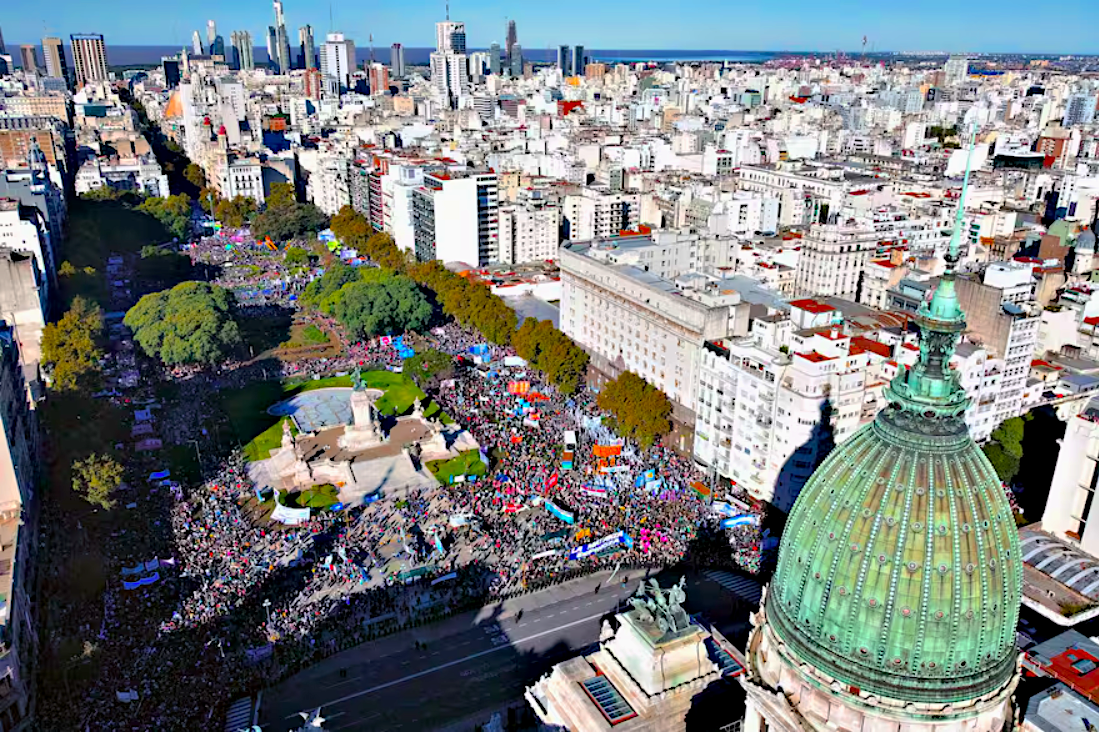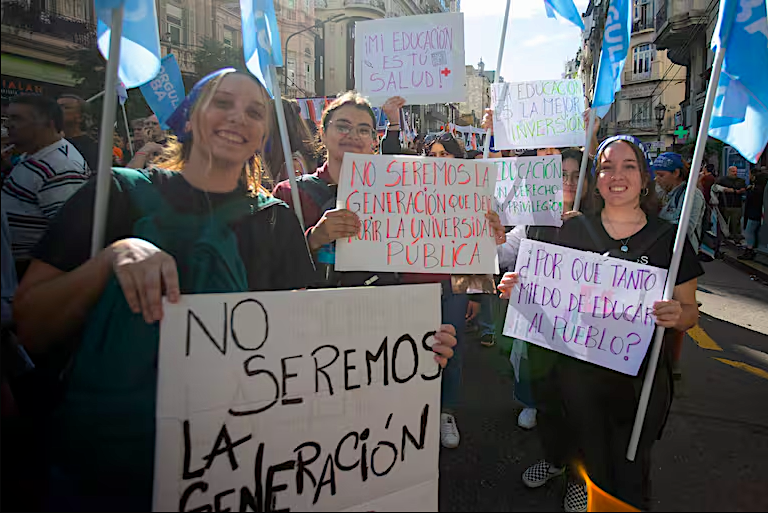
Published 04/23/2024 18:25 | Edited 04/23/2024 20:10
This Tuesday (23), at around 4 pm, the streets of Buenos Aires were completely taken over by a diverse and engaged crowd. The federal university march in the city was already massive, with the National Congress and its surroundings full of protesters. Different columns mingled at the intersections, representing different institutions and organizations. Protesters also gathered in Córdoba, Rosario, Chaco and in several cities across the country, in addition to filling buses to Buenos Aires.
The call to march was broad and diverse based on an unimaginable fear for Argentines: the end of the public university. Young people from the Carlos Pellegrini Higher School of Commerce, linked to the University of Buenos Aires (UBA), marched side by side with students, teachers and members of the academic community from different areas. The message was clear: “UBA is not for sale, UBA is defending itself”.
The demand is for the updating of the budget, the salaries of teaching and non-teaching staff, the deterioration of the scientific system and the suspension of ongoing scientific and university infrastructure works.
Read also: Conflict between mothers and grandmothers in Plaza de Mayo against the Government resurfaces in Argentina
Without funding, Argentine universities are on the verge of collapse
Argentina’s largest trade union central announces general strike against Milei
The cut also impacted institutes and hospitals that depend on the university budget. Transfers of items to university hospitals fell by 72%. Authorities have warned that the impact on hospitals is even greater because health inflation was higher. Marcelo Melo, director of Hospital de Clínicas, which depends on UBA, highlighted, for example, that the increase in medications used was 1000%.

A medical student carried a sign with the phrase: “We will not be the generation that lets the public university die”.
In Argentina there are 65 state university centers where the vast majority of students at this level in the country study. According to the Statistical Yearbook of the Secretariat of University Policies 2022 of the then Ministry of Education (today the Secretariat of Education), the latest data available, that year there were 2,714,277 university students across the country, of which 2,162,947 studied at universities and state colleges (80%) and the remaining 551,330 (20%) in private institutions. In 2022 there were 122,769 foreign university students, of which 91,484 attended public centers and 30,785 attended private centers.
In an event planned to take place around 6 pm in Plaza de Mayo, a document in defense of public education would be read, thus ending a remarkable day of mobilization and solidarity in favor of Argentine higher education.
All over the country
Focusing on the training of scientists and technologists, the Balseiro Institute celebrated yesterday 69 years of its creation in Bariloche amid the “fragile budgetary situation”, a condition that exemplifies the situation of institutions across the country.
“The lack of an approved budget for 2024 means that the 2023 budget only covers a third of the year to carry out Balseiro’s activities. We will not be able to operate in the second or third quarter with the allocated resources”, warned the institution’s director, Mariano Cantero.
A few days ago, Balseiro’s academic council decided to join today’s march in defense of public education. “We are part of Bariloche and having maintained this institution as a State policy, with a clear focus on the development of science and technology, has made the National Atomic Energy Commission one of the most important factories for technology companies in Argentina,” said Cantero.
In the important city of Córdoba, the march in defense of public universities was also massive. It crossed a good part of the city center, from the Monument to the 1919 University Reform to Pátio Olmos. Both governor Martín Llaryora and the mayor of the capital, Daniel Passerini, spoke out on their social networks in favor of the demand, as did national senator Luis Juez.
The president of the University Federation of Córdoba (FUC), Aylén Orellana, stated that, in addition to the “budget cut in universities, there is an adjustment from which young people are not immune. We are going through a crisis in the price of rent and the basic food basket. The national crisis is reflected in the student body.”
Milei in panic
In the Government they claim that the controversy with universities is over and that today’s appeal across the country “is a political march”. President Javier Milei unleashed a flurry of messages criticizing the protest and downplaying the demands. Milei replicated messages from leaders and accounts that publish far-right content, arguing against an alleged “politicization” of the force measure and suggesting that the mobilization was being carried out against audits and fund reviews.
An image shared repeatedly by Milei showed flags with slogans and the logos of the CGT and the Communist Party in Plaza de Mayo. The caption suggested that the march was political and did not represent the interests of students, as claimed.
One of the comments shared by Milei, attributed to Javier García, questioned the motivations behind the mobilization, accusing some of the protesters of seeking to politically oppress a non-Peronist government.
The self-styled Lady Market also had her message shared by the president, criticizing protesters for their supposed lack of engagement on other social issues. Milei also echoed the distrust regarding the lack of funds alleged by the university cloister, highlighting expenses allegedly inconsistent with the march.
Split between reactionaries
The internal division is a reality among Milei’s allies in the Buenos Aires Legislature, with four blocs in the Chamber of Deputies and three in the Senate. Recently, one of these groups that operates politically aligned with La Libertad Avanza in the province of Buenos Aires distanced itself from the government with a statement in defense of public education and its financing.
The message from the nine provincial deputies allied with President Javier Milei came before this afternoon’s university march at Congress and Plaza de Mayo, demanding state funding for universities and defending public education. For Milei, this is a “political” mobilization, orchestrated by the opposition.
“The deputies from the province of Buenos Aires who make up the Unión Renovación y Fe bloc once again express our commitment to defending public education, a historical pride of our country. The healthy discussion that the national government has proposed to have about the size of the State and its responsibilities cannot in any way affect the fulfillment of its essential obligations”, says the letter from the libertarian legislators of Buenos Aires.
From Unión Renovación y Fe, they stated that they “do not act together” with the main block of libertarians and that this is not the first time that they have expressed disparate positions. They had already drawn differences, for example, in the tone of the complaints that arose from the ruling party, mainly from Milei, against the artist Lali Espósito.
As yet another protester, the president of the Radical Civic Union (UCR) gave his opinion on the Executive’s attacks on public universities, under insults from left-wing protesters: “The public university and public education is what made us as a society, it is what structured our entire society. A society that has or has had social mobility is a middle class society, which differentiated us from other countries and made it difficult for us to reach the level we reached in Argentina.”
The former head of the government of Buenos Aires, Horacio Rodríguez Larreta, posted a photo on his X account, in which he appeared alongside a group of students. Rodríguez Larreta’s support for the university demand adds to the consensus that has spread to the “dialogue” sectors with libertarians. From the Radical Civic Union (UCR) to the Justicialista Party (PJ), through the Civic Coalition (CC), the Renewal Front (FR) and the Left and Workers Front (FIT), several political sectors were present at the march.
Source: vermelho.org.br

